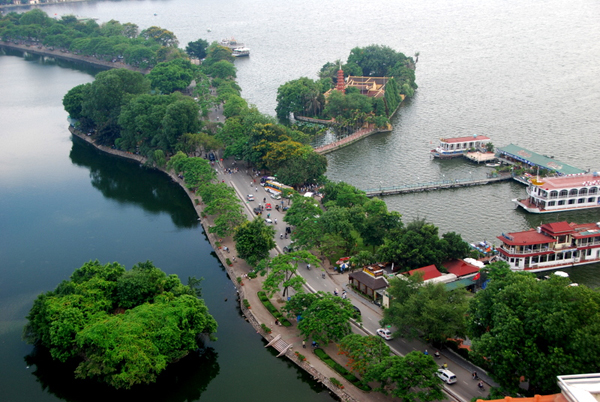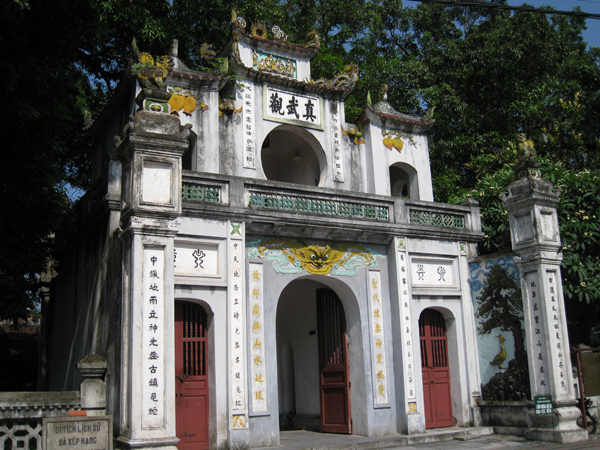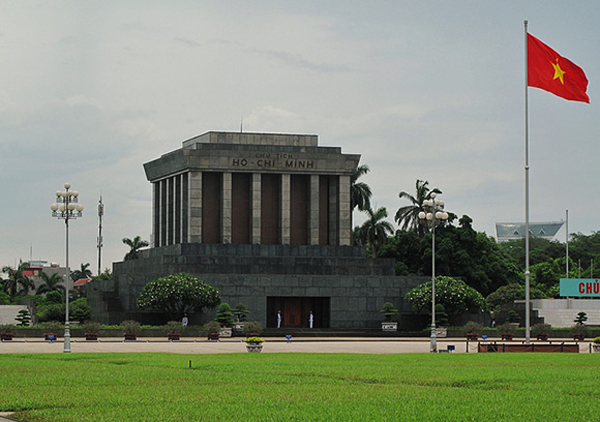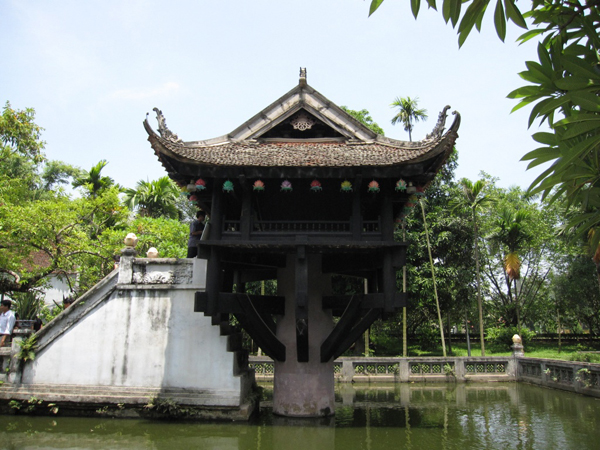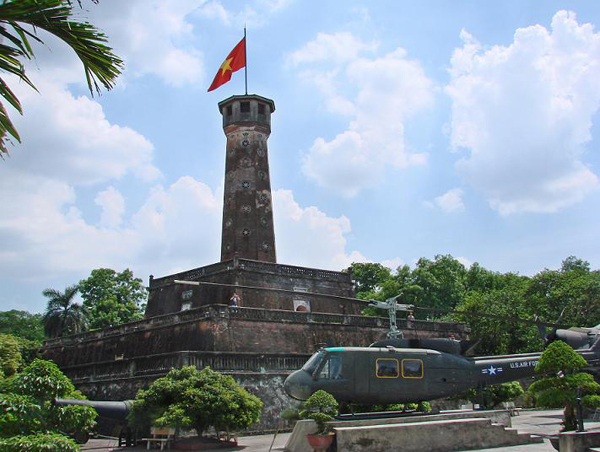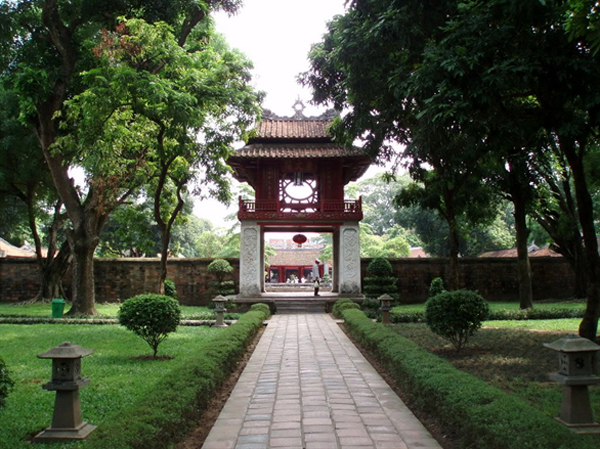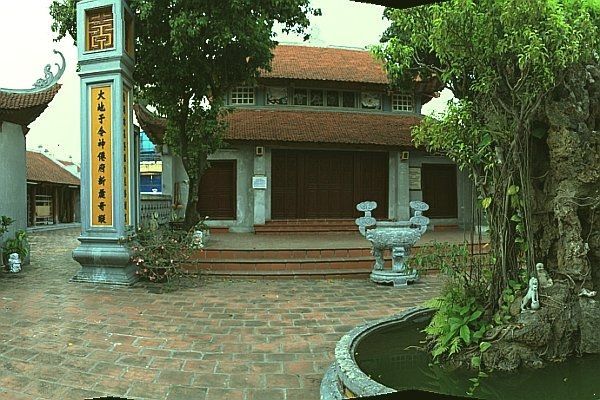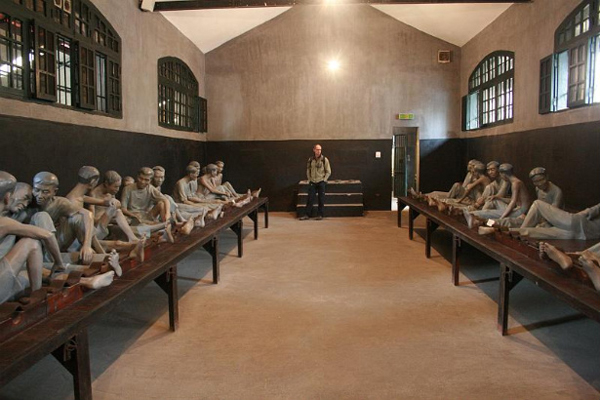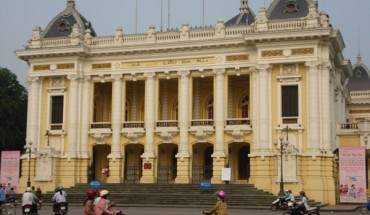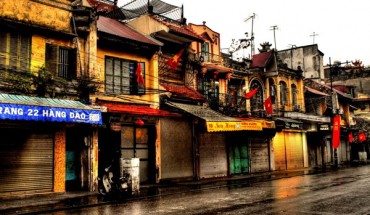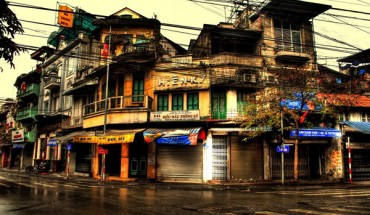Hanoi City Tour Itinerary
Tran Quoc Pagoda – Quan Thanh Temple – Ho Chi Minh’s House and Mausoleum – On Pillar Pagoda – Cot Co Flag Tower – Temple of Literature – Bich Cau Temple – Ambassadors’ Pagoda – Maison Centrale (Hanoi Hilton) – Opera House
A good place to start a tour of Downtown Hanoi’s lakes, temples and pagodas is the Tran Quoc Pagoda (Chua Tran Quoc), picturesquely situated on an island to the west of the causeway which separates Truc Bach Lake from the larger Ho Tay, or West Lake. From Tran Quoc it is easy to appreciate the key role which the shifting waters of the Red River have played in the shaping of the Vietnamese capital over the centuries.
Tran Quoc – ‘Defend the Nation’ – Pagoda is one of Vietnam’s oldest temples, possibly dating back to the 6th century Early Ly Dynasty. A stone stele of 1639 still preserved in the temple grounds records that it was relocated here in the 15th century to protect it from the encroaching Red River.
A Taoist Temple
A Taoist Temple From Tran Quoc walks or takes a taxi south along Thanh Nien road causeway. To the east lie the still waters of Truc Bach or White Silk Lake. During the 18th century, the Trinh Lords built a summer palace here, which was later transformed into a place of detention for errant royal concubines, who were obliged to weave a particularly fine white silk – hence the name of the lake.
Turn east on leaving the causeway and enter the grounds of Quan Thanh Temple (Den Quan Thanh) built by the founder of the Early Ly Dynasty, Ly Thai To, in the early 11th century. The temple – rebuilt several times, most recently in 1893 – is dedicated to Tran Vo, Guardian of the North, who protects the city from malevolent influences. An image of this Taoist god, accompanied by his symbols of power, the turtle and the snake, cast in bronze by Trum Trong in 1677, stands nearly 4m (13ft) high on the main altar. A statue of the celebrated master craftsman stands to one side.
Ho Chi Minh Complex – Lang Bac Ho
Ho Chi Minh Complex – Lang Bac Ho Located on Duong Hung Vuong Boulevard, Hanoi Botanical Gardens and the present Presidential Palace (Phu Chu Tich), the latier a beautifully restored example of French colonial architecture originally constructed in 1906 as the Palace of the Governor General of Indochina.
Although closed to the public – nowadays it is used to receive visiting heads of state – it is possible to walk through the palace grounds by a clearly indicated route to visit Ho Chi Minh’s House or Nha San Bac Ho (Tue-Sun 8-1 lam and 1.30-4.30pm), an unassuming residence raised on stilts where Ho Chi Minh spent the last decade of his life. The house is airy, with a neat garden beside a small pond. On the first floor, Uncle Ho’s bedroom and study are preserved as he left them – clean and somewhat spartan.
Immediately to the south lies the symbolic heart of the Socialist Republic of Vietnam, with the Ho Chi Minh Mausoleum (Tuesday to Thursday 8-11am; usually closed October to December) facing the National Assembly across Ba Dinh Square. It was in this square that Ho Chi Minh read the Vietnamese Declaration of Independence on 2 September 1945, and it is here that his body was kept several years after his death on 2 September 1969.
The mausoleum, a monolithic grey structure built in the Soviet Union style, was constructed from 1973 to 1975, using marble, granite and rare woods brought from all over Vietnam. Visitors may enter and view Ho Chi Minh’s embalmed body, but only briefly as military guards keep the line of visitors moving swiftly along. It is essential to dress correctly. Cameras and bags must be left behind.
A Unique Pagoda
A Unique Pagoda On leaving the mausoleum, continue south for about 200m (656ft) before turning west along Chua Mot Cot, the road named for Hanoi’s famous One Pillar Pagoda or Chua Mot Cot, a small but elegant wooden pagoda built by King Ly Thai Tong (1028-54) of the Early Ly Dynasty.
According to tradition, Quan The Am Bo Tat, better known as Kuan Yin, the Goddess of Mercy, appeared to the heirless king in a dream. Seated on a lotus throne, she handed him a baby boy. Soon after Ly Thai Tong married a young peasant girl who bore him a son and heir. To commemorate this event and give thanks to the Goddess, Ly ordered the construction of Chua Mot Cot, in the shape of a lotus flower, in 1049. The single column on which the pagoda rests in a tranquil lotus pond represents the ‘stem’ of the temple.
The bo tree behind the temple was planted by President Nehru of India during a state visit in 1958 and is said to be an offshoot of the one under which the Buddha attained enlightenment. The attractive facade of the nearby Dien Huu Pagoda opens onto a quiet garden courtyard – a good place for a contemplative moment, though many Vietnamese visitors come for the acupuncture treatment with which the temple is associated.
Close by – indeed so close that it dominates both pagodas – is Ho Chi Minh Museum (daily 8-11am, 1.30-4.30pm), which opened on 19 May 1990, the centenary of Ho’s birth. Exhibits concentrate on Ho’s life, the development of the Vietnamese revolution, and displays of the great leader’s personal effects.
The Hanoi Flag Tower
The Hanoi Flag Tower After visiting the museum, head back east along Chua Mot Cot Road until you reach Dien Bien Phu, a long boulevard of shady trees and ginger-bread colonial buildings, nearly all of which have been restored in recent years.
After about 500m (1,640ft), opposite the Lenin Monument, stands the Army Museum (Tue-Sun 8-11lam, 1.30-4.30pm) or Bao Tang Quan Doi. This merits a visit, providing well-presented displays of Vietnamese military history, essentially during the struggle for independence and the subsequent war in the south.
The museum courtyard – which is full of weaponry from the Indochinese Wars, including a Russian MIG 21 fighter – marks the southwestern corner of the Citadel, formerly the centre of administration in pre-colonial times and today a restricted military area in the heart of Hanoi.
Fortunately Cot Co Flag Tower, which is perhaps the most interesting feature of the Citadel, is open to the public and well worth the climb for the views over the city to the Red River and the Long Bien Bridge.
From Cot Co head south past the Lenin Monument and the Chinese Embassy until you reach busy Nguyen Thai Hoc. Turn west and walk a short distance to the National Fine Arts Museum (Tue-Sun 8am-noon, 1.30-4.30pm) which offers displays of art history from Dong Son, through the Kingdom of Champa and the pre-colonial Vietnamese dynasties, to more recent – but fast disappearing – Socialist Realism.
Temple of Literature Just across Nguyen Thai Hoc, heading due south, is the smaller Van Mieu Road which leads to the Temple of Literature 14 or Van Mieu, one of Vietnam’s foremost cultural treasures. Founded in 1070 by King Ly Thanh Tong of the Early Ly Dynasty, the temple was originally dedicated both to Confucius and to Chu Cong, a member of the Chinese royal family credited with originating many of the teachings that Confucius developed 500 years later. The site was chosen by Ly Dynasty geomancers to stand in harmony with the Taoist Bich Cau Temple and the Buddhist One Pillar Pagoda, representing the three major fonts of Vietnamese tradition.
In 1076, the Quoc Tu Giam, or ‘School for the Sons of the Nation’, was established at the same location when King Ly Nhan Tong (1072-1127) founded Vietnam’s first university. The tradition of Confucian education flourished at the Temple of Literature, with the custom of offering a cloak to successful candidates beginning in 1374, while in 1484 the first stele bearing the names of doctoral graduates was erected.
After 1802, with the establishment of the Nguyen Dynasty and the transfer of the capital to Hue, the Royal University was moved too. Van Mieu continued to function, but the Quoc Tu Giam buildings were turned into a shrine to the parents of Confucius called Khai Thanh.
Nevertheless, in 1947, at the beginning of the First Indochina War, French shells demolished both Khai Thanh and the Houses of the Disciples in the Courtyard of the Sages. The Vietnamese clearly learned a lesson from this disaster, for during the Second Indochina War; many precious objects at the Temple of Literature were put into storage, while the stelae were buried in sand and surrounded by a reinforced concrete wall as protection against stray American bombs. In 1988, as a result of liberalization, the statues of Confucius and his disciples were restored to the temple and the complex opened to the public.
Entry to the complex is through Van Mieu Gate. The layout, modeled on that of the temple at Qufu in China’s Shandong province where Confucius was born, consists of a succession of five walled courtyards. The first two courtyards, joined by Dai Trung Mon or ‘Great Middle Gate’, are carefully maintained gardens of tranquility where locals come to paint, read or converse quietly in the shade of the trees.
The third courtyard is reached via Khue Van Cac or ‘Pavilion of the Constellation of Literature’, a fine double-roofed gateway built in 1805. The visitor will find the Garden of Stelae – 82 stone memorials mounted on the backs of tortoises, each listing brief biographical details of graduates of the Temple of Literature dating back.
Restoring Tradition
The French – who demolished numerous historical buildings in the region when building their new administrative quarter at the turn of the 19th century – appreciated the unique significance of the temple complex and made it a protected historical building in 1906.
to the 15th century – a total of 1,306 scholars. In the centre of the courtyard is a walled pond called Thien Quang Tinh, which translates into ‘The Well of Heavenly Clarity’.
The Inner Courtyards
Entry to the fourth courtyard, or Courtyard of the Sages, is via Dai Thanh Mon, or ‘Gate of the Great Synthesis’. It was here, in the Great House of Ceremonies, that in times past, the king would make offerings at the Altar to Confucius while new university graduates would kneel and prostrate themselves to pay respect.
Behind the Great House of the Ceremonies is the Sanctuary with statues of Confucius and his leading disciples including Manh Tu or Mencius Flanking the courtyard to the east and west were once altars to the Houses of the Disciples of Confucius, but these were destroyed in the shelling of 1947 and have been replaced by a shop, a small museum and administrative offices. This courtyard is still used for chess games using people as live chess pieces, and for ceremonial dances, during the Tet festivities. The fifth and final courtyard once housed the Royal’University and, following the transfer of the capital to Hue in 1802, the Khai Thanh shrine to Confucius’ parents. Again, and most unfortunately, these buildings were destroyed by shelling in 1947. At present, the fifth courtyard contains the Lieu Hanh Shrine, dedicated to the goddess who is one of the ‘Four Immortals’ honored by Vietnamese tradition.
Bich Cau Temple
About 250m (820ft) southwest of Van Mieu on Bich Cau Street is Bich Cau Taoist Temple (Dao Quan Bich Cau), the third temple in the symbolic geomantic triangle of the Ly Kings, together with Confucian Van Mieu and Buddhist Chua Mot Cot. Bich Cau was re-dedicated to the Immortal Ta Uyen who helped King Le Thanh Ton inflict a crushing defeat on the Kingdom of Champa in 1471.
Bich Cau consists of three buildings – a Taoist temple in the centre, a smaller Buddhist temple to the right, and living quarters for religious functionaries to the left. Inside the main Taoist shrine stands an altar to Ta Uyen, with the Immortal in the middle flanked by statues of his wife and son.
Downtown Hanoi
From Van Mieu head east along Nguyen Thai Hoc, turn south down Duong Le Duan and take the third turning to the east along busy Pho Tran Hung Dao. You are now entering the commercial heart of downtown Hanoi, most of which was built by the French and now gradually going high-rise.
One small pagoda of distinction survives in this bustling business area, however – take the second turning north along Pho Trang Hung Dao and, at 73 Quan Su Street is the Ambassadors’ Pagoda 0 (Chua Quan Su). Little of the original 17th-century structure survives – the pagoda in its current form dates mainly from 1930. Once a reception house for ambassadors from Buddhist countries (representatives of other nations enjoyed less favored status), today it is an active and popular Buddhist establishment.
From Chua Quan Su head north a short distance to cross Pho Ly Thuong Kiet, turn eastwards and take the first road on the left along Pho Hoa Loa.
On the west side of this small cross street stand all that remains of the Maison Centrale much- feared prison built by the French in 1896 where thousands of Vietnamese political prisoners were held during the colonial period.
Today it is better known to Western visitor as the Hanoi Hilton – a wry sobriquet given by US prisoners-of-war held here during the Second Indochina War. In recent years, the greater part of the old prison has been torn down to make way for a glittering high-rise tower and little but the ochre-colored main entrance and a small museum remains of the original building.
More War Relics
From the Maison Centrale, head north across Pho Hai Ba Trung to Pho Trang Thi and continue east past the southern shore of Ho Hoan Kiem. This is the busy heart of downtown Hanoi, and a good place both to eat and shop. Here, make a small detour north along Ngo Quyen to see the former Residence of the Governor of Tonkin. Built in 1918, this attractive colonial building now serves as a State Guest House for important visitors.
The main attraction in this area, however, lied at the eastern end of Pho Trang Thi – the restored Opera House, now known officially as the Municipal Theatre (Nha Hat Lon). This fine building, modelled on the neo-baroque Paris Opera, would be much admired in any major European capital. During colonial times, the Opera House was regarded as the jewel in the crown of French Hanoi and the most sophisticated expression of French culture in all Indochina.
To the east of the Opera House, near the Red River embankment, are a number of museums including the Revolution Museum, the Geology Museum and the History Museum (Tue-Sun 8.15-11.45am, 1.15-4.30pm). Founded in the 1930s by the prestigious Ecole Frangaise d’Extreme Orient, this unusual building in Franco-Vietnamese style holds an interesting collection of artefacts from Vietnamese, Cham and Khmer history.
Excursions from Hanoi
Co Loa – My Chau Temple – An Duong Vuong Temple – Perfume Pagoda – Thay Pagoda – Tay Phuong Pagoda – Bat Trang – Van Phuc – Dong Ky – Soc Son Pagoda – But Thap Pagoda – Hoa Lu – Museum of the Nationalities of Vietnam
There are a number of significant and interesting sites around Hanoi that are well worth visiting. Taken collectively, however, they do not constitute a single tour, being scattered at all points of the compass and at varying distances from the Vietnamese capital.
The best solution for those wishing to explore the area is to stay in the capital and travel by hired car or taxi to the various destinations, perhaps combining two or three in a single day if they all happen to be in the same general direction.
You may interested in Hanoi tours.


